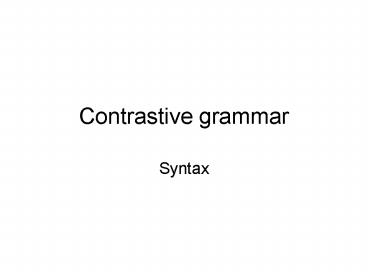Contrastive grammar - PowerPoint PPT Presentation
1 / 19
Title:
Contrastive grammar
Description:
Syntax incorporates the grammar /structure of phrases, clauses, and sentences. Sentences/clauses ... Sit is in the imperative mood. Jestem. Word order. Word order ... – PowerPoint PPT presentation
Number of Views:93
Avg rating:3.0/5.0
Title: Contrastive grammar
1
Contrastive grammar
- Syntax
2
Syntax Definition
- Syntax is the rules by which linguistic items are
combined to make statements. - Syntax incorporates the grammar /structure of
phrases, clauses, and sentences
3
Sentences/clauses
- A clause is a grammatical unit that
- includes, at minimum,
- a predicate and an explicit or implied subject,
and - expresses a proposition.
- Examples (English)
- two clauses
- It is cold, although the sun is shining.
- The main clause is it is cold
- the subordinate clause is although the sun is
shining.
4
Sentence
- A sentence is a grammatical unit that is composed
of one or more clauses. - The meaning of the term sentence may be expanded
to include elliptical material and nonproductive
items. - Examples
- After lunch. (in reply to When do you start?)
- Yes.
- Hello.
- Example (English)
- I am reading a book.
5
Predicate
- A predicate is the portion of a clause,
- excluding the subject,
- that expresses something about the subject.
- Example
- The book is on the table.
6
Basic elements
- The sentence
- consists of phrases.
- The central constitutive element is
- the verb phrase/the verb.
- There are normal sentences which consist only of
the verb phrase. - Sit!
- BUT
- Sit is in the imperative mood
- Jestem.
7
Word order
- Word order
- the order in which words appear in sentences
across different languages. - All languages are generally assumed to have a
basic word order. - That word order is unmarked.
- it contains no extra information to the listener.
- English is SVO, as in "I don't know this,"
- but OSV is possible "This I don't know."
- The OSV is a marked word order because it
emphasises the object.
8
Word order
- These are all possible word orders for the
subject, verb, and object - SOV languages include Dutch, German and Japanese.
- SVO languages include English and French.
- VSO languages include Classical Arabic and
Gaelic. - VOS languages include Fijian.
- OSV languages include Xavante.
- OVS languages include Hixkaryana and Klingon.
9
Word order
- There are additional trends in word order.
- SOV languages generally put modifiers (adjectives
and adverbs) before what they modify, and use
postpositions. - VSO languages put modifiers after, and use
prepositions. - In SVO languages, either order is possible.
- For example French is SVO.
- It uses prepositions (preposition-object), and
- places adjectives after (head-modifier). However,
- a small class of adjectives generally go before
their heads.
10
Word order
- English
- Adjectives always go first (modifier-head).
- Adverbs can go either way, but initially is more
common. - Prepositions, but sometimes a sentence (clause)
is best with a preposition used to end it with
(depends on the verb).
11
Basic differences
- in an analytic language a change of word order
may result in change of meaning or
ungrammaticality - The boy bit the dog
- in a more typically synthetic language inflection
can take care of the grammatical information - Psa ugryzl chlopiec
- BUT
- Tramwaj rozbil samochód / Samochód rozbil tramwaj
- AccNom
12
Analytic-synthetic
- Some information (some linguistic categories)
that in a synthetic language - are transmitted through bound morphemes
- ide
- in an analytic language
- are transmitted through free morphemes (words)
- I am going
13
English-Polish Basic differences
- Word order
- English
- primarily analytic
- primarily fixed word order
- word order identifies syntactic functions
- Polish
- primarily synthetic
- becoming analytic
- primarily free word order
- inflection identifies syntactic functions
14
More examples
- English
- The girl hit the boy.
- ?The boy hit the girl.
- Hit the girl the boy.
- Polish
- Dziewczynka uderzyla chlopca.
- Uderzyla chlopca dziewczynka.
- Chlopca dziewczynka uderzyla.
15
English Functions
- Subject
- NP before (to the left) of VP (Predicate)
- Object
- NP after (to the right) of VP (Predicate)
16
English-Polish
- Adjectives
- English
- before the noun (with some exceptions)
- court martial
- Polish
- before or after the noun
- with a difference in meaning
- niedzwiedz brunatny
- brunatny niedzwiedz
17
English-Polish
- Determiners
- English only before the noun
- Polish either way
18
Syntactic constructions
- a number of English constructions have no
counterpart in Polish - I want him to go.
- There is a man in the kitchen.
- It is Mark who will go there.
19
- a number of Polish constructions have no
counterpart in English (and they are difficult to
analyse) - Jest mi dobrze.
- Chce mi sie spac.
- Wesolo mi.
- Bo z mezami jest jak z bankami mydlanymi.































